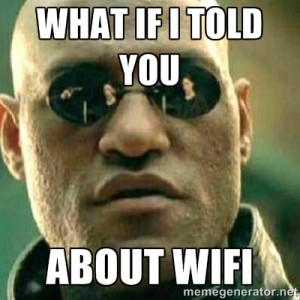 The perceptions, the reality, and the right questions to ask about providing fast, reliable wireless Internet access for your attendees.
The perceptions, the reality, and the right questions to ask about providing fast, reliable wireless Internet access for your attendees.
As a society we are consuming data at an alarming rate, setting new records each year as more and more smart devices get purchased and put into use. What does that have to do with your meeting or conference? Everything. With growing numbers of places — libraries, bookstores, coffee shops, and entire downtowns — providing free Wi-Fi, attendees now show up at a venue expecting the same thing.
How can you meet their expectations without blowing your budget out of the water, or having to ask your venue to give something away that is undoubtedly a large profit center? By understanding the perceptions that each of the major players has, and working through them.
FOUR PERCEPTIONS
- The attendee: When the W-Fi connection at a show isn’t fast, secure, and free, the attendee starts thinking, “If I can go down the street and pull Wi-Fi from McDonald’s for free but not the show I am paying good money to attend, that is a problem!”
- The show organizer: Most show organizers that I have spoken to over the last year or so view Wi-Fi like air, in so far as it doesn’t cost the facility anything to turn on since the access points are already there, you don’t see it, there is no real labor involved to use it, and it is something that we all need.
- The third-party planner: While most third-party planners relate and empathize with the show organizer and the attendee, at some point I am sure they think, “Most people carry 3G- or 4G-enabled smart devices. Let’s forget Wi-Fi all together and just have them use their personal devices!”
- The facility: Believe it or not, the facility doesn’t have a much better understanding of Wi-Fi than anyone else. That is why they contract their Wi-Fi services to a third party, who tries to convey that there is a cost associated with the bandwidth being requested and with upgrading and maintaining the current system.
SIX QUESTIONS
The best way to work through these perceptions and get everyone on the same page is to start asking questions:
- Why does McDonald’s have free Wi-Fi and the venue does not? These places offer much smaller networks to run for a significantly decreased amount of people for a very limited amount of time — i.e., as long as it takes you eat your Happy Meal and fries.
- The Wi-Fi access points are already there, so it doesn’t cost anything to turn it on, does it? As stated earlier, many meeting facilities outsource Wi-Fi service to a technology supplier, which pays a percentage of the user fee back to the facility in commission. And bandwidth does cost money to provide.
- Why can’t attendees just use their own cellular 3G and 4G data plans instead of Wi-Fi? While this might eventually happen, the reality is that it isn’t a foregone conclusion. For one thing, smartphone providers are clamping down on unlimited-data plans. Not to mention that not everywhere in a facility gets great signal strength (hence the advantage in native mobile apps ass opposed to web apps).
- What type of Wi-Fi package are you buying? Providers usually will package their Wi-Fi in one of two ways: concurrent connections or total bandwidth available. Knowing the Internet habits of your attendees — emailing and casual browsing vs. streaming and Skyping — will help you figure out which one to purchase.
- What happens if you exceed your allotted purchases? Get an answer — and a plan — in place before going on site. Once you’ve reached maximum capacity, some facilities will not let additional connections and users in, while others will keep letting users join at a significantly higher price point.
- What type of equipment does the facility have? 802.11g, 802.11b, 802.11a, 802.11ac, 802.11n etc. Each one of these access point models do very different things and can ultimately effect the performance of the network at the facility.
Always ask what type of access points a facility has along with number of each the meeting rooms and through put of each. Then of course know what the answers to each of these mean and how it can affect your show.
There are of course additional questions to ask but this will be a good start and convey to your facility that you know something about wireless, how it works and how it should be priced.
Latest posts by Tim LaFluer (see all)
- The Truth About WiFi for your Attendees - July 31, 2013

